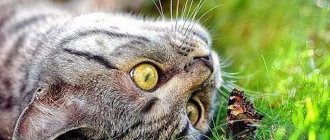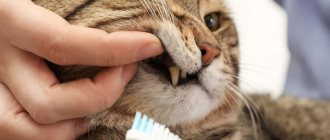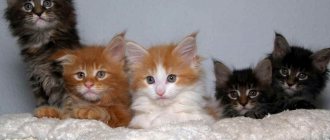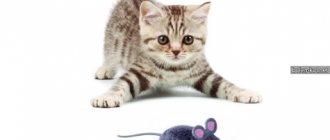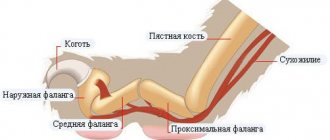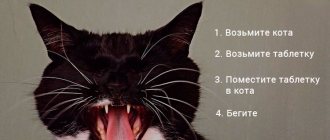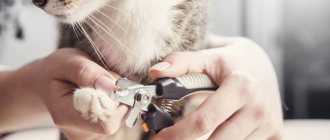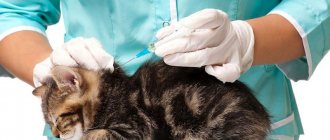Every owner, when a kitten appears, worries about the integrity of his furniture, wallpaper, and curtains. In addition, kittens often lose their claws, clinging to carpeting. To protect the cat from damage to its claws and prevent dirt and germs from getting under them, they came up with the idea of gluing the cat’s nails, thereby eliminating problems.
Advantages and disadvantages
Positive aspects of using anti-scratch for cats:
- Safety of household goods.
- Avoid scratching the skin when the animal is sick.
- Facilitation of hygienic and medical procedures.
- Self-sticking and removal.
- Availability of material.
But it is worth considering the disadvantages of this procedure:
- The cat will not be able to fully clean its fur and ears.
- Chewed off plastic caps can be swallowed by a cat.
- If the animal ends up on the street, it will not be able to run away from the enemy into a tree or fight back.
- You can also forget about catching mice.
View this post on Instagram
Posted by Marina Grumer (@marinagrumer) Aug 15, 2021 at 12:00 pm PDT
Veterinarian advice
Before purchasing silicone pads for your cat, you should listen to the advice of your veterinarian:
- Only a healthy animal that does not have fungal or infectious lesions on its paws should be glued with silicone caps. If there are wounds or irritations on the pads and between the toes, it is better to abandon soft claws for a while and cure the animal.
This is what healthy claws look like
- Since various microorganisms and fungi can accumulate between the hood and the pad, you should regularly check your cat's nails with a scratch treatment for infectious and fungal diseases.
- If glue gets on the skin during the procedure, the claws will grow and pull it along with them. In addition to the fact that the resulting cracks are very painful, they can become infected. Therefore, the paws need to be inspected daily and the pads should be glued on very carefully.
- The cat may have an individual intolerance or allergy to glue. If irritation, swelling, or hyperemia (redness) occurs on the toes or between the toes, consult a veterinarian. It will likely be necessary to remove the caps and treat the animal accordingly.
When you decide to give your beloved cat a charming and practical “manicure”, it is worth reading on the forums not only the reviews of veterinarians, but also the opinions of cat lovers who have already experienced anti-scratch treatments in practice.
Before the procedure, it is very important to take into account both positive and negative opinions, analyze them and make an informed decision that will not harm the animal.
And let all the fashionistas die of envy
Is there any harm to cats?
The pads do not cause any harm to humans; on the contrary, they relieve scratches and inflammatory processes.
A cat's natural claws will not be damaged if you choose the right size of anti-scratch claws. At the same time, the coatings are preserved without damage.
But not all cats are the same in character. Some people will not like this version of the problem, and until they get rid of plastic masks, they will not calm down. Gnawing on the pads can damage the teeth and there is a risk of swallowing the tip. But it is made from animal material that is safe for the body and has a smooth shape, so when it enters the body, the tip will calmly pass through the esophagus and come out without causing harm.
Declaw removal. Onychectomy
The first method is lousy in its essence, but works 100% for those who purchase a living creature (cat) as an architectural decoration of an apartment design - onychectomy. This “remedy” is resorted to by those furniture owners who want to keep it intact in exchange for the suffering and health of the animal that has trusted them.
The essence of the method is an operation to remove a cat's claw along with part of the finger without medical indications. The horny formation on the last phalanx of the finger in most vertebrates is called a claw or nail. By looking at your hands, you will see how nails differ from claws.
A common fact is that in order to completely get rid of a nail-claw and prevent its growth in the future, it is necessary to cut off the part of the finger on which this horny formation “grows.”
If after such an intervention a part of the phalanx remains, then the claw will grow again, but the horny plate will no longer grow outward, but inside the finger, which will entail unbearable pain, the development of an inflammatory process and a new, more complex operation and long-term treatment.
Excision of the flexor-extensor ligament of the claws (after the operation the cat cannot extend and retract its claws) does not carry anything “new” in comparison with onychectomy itself: the same anesthesia, the same scalpel or forceps, the same pain, the same high probability of recovery tendons.
Consequences of onychectomy
Surgical intervention is followed by irreparable changes in the cat’s condition, such as constant pain, stress, dysfunction of the musculoskeletal system, loss of coordination, osteomyelitis, arthritis, etc.
Since the cat, when walking, relies on the tips of the first phalanges of the fingers and the edges of the claws, after removing the phalanges, it will no longer be a ballerina - it will have to learn to walk again, shifting the main emphasis when stepping to the pad of the paw.
Having accustomed its body to move like a bear, the cat will disrupt the natural, given to it by nature, uniform load between the muscles of the body, as a result of which some of the muscles will be overworked, and others will begin to atrophy. Where is the elegance and grace of a panther! I wish I could get to the bed, overcome the persistent pain in my stumps and throughout my body!
By the way, it is very painful to rake out the litter in the tray with a burning, aching paw; many cats simply refuse to follow the rules of hygiene after onychectomy.
Having realized that they can no longer use their claws, cats often begin to use their last remaining means of defense - their teeth. Considering the deteriorated nature, due to constant pain, teeth are used much more often than “zealous” furniture owners would like.
Often unfortunate animals are thrown out onto the street, since being next to an aggressive and “disgusting” animal becomes simply unbearable, and then a quick and often painful death from hunger or the first stray dog.
The only thing that benefits from all this is the sofa and new wallpaper. The worst thing is that the second generally accepted name for this inhumane action sounds mockingly affectionate - “Operation anticorpi or soft paws”.
It is possible to resort to cutting off the phalanx of a finger (onychectomy) only in cases where surgical intervention is necessary to save the life and health of the pet, when drug treatment in the area of the metacarpus or metatarsus has not given the desired result.
Reviews from veterinarians about such unauthorized interventions in the body of a healthy animal at the whim of the owner are extremely negative. And any doctor who respects his profession should not promote the scalpel, patting his pocket (the cost of the operation is from 3 thousand to 8 thousand), but try to dissuade the unreasonable owner from an operation that will make a healthy animal crippled for life.
Today, such fanaticism is not prohibited by law in Russia and other neighboring states.
In the USA, the doctor and the owner can be jailed for a certain period of time under the article “cruelty to animals.” In the UK, you will get off with a large fine and license suspension for up to 5 years. In many countries, cats that have undergone surgery are permanently removed from the show ring.
When not to use anti-scratch products
It is not always appropriate to use overlays. This is in such cases:
- The kitten is not yet six months old; it has soft small claws that wear off on their own during play.
- Older cats: an older animal does not show much interest in games or household items.
- Animal intolerance to artificial materials from which the product is made.
- If the cat is characteristic, he does not like innovations on himself.
- When a cat is outside, it will not be able to protect itself.
Useful video on the topic:
Service life of caps
Properly glued pads in a healthy cat usually last 1.5-2 months. During this period, the animal's claw cornea is renewed. The hood will fall down along with the dead part of the claw. When this happens, all you have to do is update your furry pet’s “manicure”.
A standard set of sanitary pads includes 20 caps and medical glue with a shelf life of 2 years. This means that the caps will last for two uses. If you stick scratches only on the front paws, the “manicure” can be done four times. Using arithmetic calculations, it is easy to determine that silicone gaskets will last an average of 2 months. All four paws are put on when the cat is too playful or scratches wounds on the body with its hind paws.
Silicone caps fall off on their own after a while
Particularly nervous cats that cannot tolerate invasions tear the linings with their teeth without waiting for the end of the operation. In this case, you will have to glue the scratches very often or stop using “soft claws”.
Rating of nail overlays and price comparison
In zoological stores you can buy anti-scratch products from the following brands:
- Soft Paws Nail Caps. Country of manufacture: USA. The kit includes a special glue that does not affect the animal’s body. The package may contain products of the same tone or different, there are 40 pieces in total, the package also contains 2 tubes of glue. The average wearing time is 4–6 months. Produced in all sizes.
- Soft claws from Cliny. Presented in one version - silicone in a silver shade. Non-toxic. Comfortable to wear and does not cause discomfort to the animal.
- Crazy Liberty - domestic manufacturers produce soft products in different, bright colors. The package contains 20 pieces and 1 tube of glue.
- Barbos is also domestically produced. There are 40 pieces in the package, one large tube of glue. Anti-scratch pads are multi-colored, there is a transparent option.
The price depends on the manufacturer, the material being made, and the number of anti-scratch pads in the package. On average it is 100–250 rubles.
What should you pay attention to when buying nail caps?
To choose the best rubber nozzles, you need to consider several factors:
- Degree of comfort. High-quality caps do not cause severe discomfort to the animal. After gluing, the cat’s paws should not swell and the cat’s toes should not be injured. Ideally, the cat should not notice the presence of the caps.
- True to size. If the sticker doesn't fit properly, it will quickly wear out and fall off. Products that are too small will squeeze the claw and cause pain to your pet. A special table, which is present on the anti-scratch packaging, will help you choose the right size. The determining criterion is the weight of the animal. For kittens and miniature cats weighing from 0.5 to 2 kg, caps are produced in size XS. If the pet's weight does not exceed 4 kg, then size S is suitable for it. For cats with a body weight of 4–6 kg, it is better to purchase tips in size M. For especially large breeds, such as Bengal cats, Savannahs or Maine Coons, tips marked L are produced.
- Quality of material. Some products are made from cheap materials, so they quickly fall off, crack and can cause inconvenience to cats. High-quality anti-scratch pads should be made of thin and flexible silicone. This material is wear-resistant and does not harm the animal.
- Color. This criterion is important not for pets, but for their owners. When choosing the shade of the covers, many breeders are guided by the character of their pets, while others are guided by the color scheme of the apartment’s interior.
How to glue correctly
The gluing process should not bring any inconvenience or stressful situations to the animal. Step-by-step gluing of anti-scratch protection:
- The animal must be prepared: feed it, sit it in your arms, talk calmly, pet it.
There should be no extraneous sounds in the room that distract or irritate the animal.
- You need to take the cat's paw, press lightly so that claws appear (this process is similar to the procedure with circumcision).
- Before gluing the anti-scratch pads, measure the claws to ensure they fit perfectly.
- A little glue is poured into the pad, after spreading, glue it onto the claw, press down a little.
The animal is not immediately released. We must wait until all the tips have completely hardened.
To extend the life of the pads, you can trim the claws by 1–2 mm, no more.
We recommend videos on the topic:
Professional treatment
If the pad on the paw is swollen, red, with signs of inflammation, then it is better to entrust the cat to a professional veterinarian.
The doctor assesses the depth of the ingrowth, the degree of inflammation, and decides on the need for surgery. Then:
- under local anesthesia, the doctor opens the area of inflammation;
- through the incision, accumulated pus and ingrown claws are removed;
- treats the wound with an antiseptic drug and applies a sterile bandage.
If the inflammation and deep ingrowth are severe enough, surgery under general anesthesia may be required.
After surgery, during the healing period, the cat’s treatment is supplemented with:
- antibacterial therapy to prevent infection;
- immunomodulators for rapid tissue restoration;
- adding vitamin and mineral supplements with a general strengthening effect to the diet.
Disadvantages of the device
According to manufacturers, anti-scratch pads do not affect the quality of life of pets, do not hinder their movements, and allow them to jump, play, and move around in the same way as before their installation. However, not all cat owners share this opinion. Many note that the caps have several disadvantages:
- complicate natural reflex actions;
- do not allow you to stop in a timely manner after taking off;
- make it difficult to climb up hills;
- increase the frequency of cats falling when trying to climb onto a chair or sofa, leading to injury to the animals;
- do not allow pets to fully care for themselves;
- reduce the degree of claw retraction, causing discomfort to the animal;
- deprives the cat of the opportunity to defend himself on the street;
- they make an unpleasant sound when the pet walks, creaking, knocking;
- glue can cause an allergic reaction.
